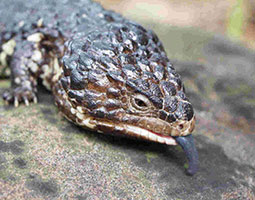Tiliqua rugosa
Description

Shinglebacks (Tiliqua rugosa) are ground dwelling, diurnal (active during the day) skinks usually found in dry to arid open habitats in southern Australia. Shinglebacks are commonly known by a number of names including Stumpy-tail, Pinecone Lizard and Boggi. Shinglebacks are readily identifiable via their large, dark rugose (rough) scales.
Shinglebacks grow to an average length of 40 centimetres. Colour ranges from brown, to black, usually with irregular pale bands on the body and tail. Their ventral (underneath) surface is cream to white with dark streaks, stripes or bars.
Shinglebacks mate in spring. Like the closely related blue tongues, Shinglebacks are live-bearers (viviparous), usually producing 2 young in late summer.
Adaptations
- Excellent camouflage
- Dark colour allows it to absorb heat from its surroundings
- Similarity of the head and tail may confuse some predators
- Live young and maternal behaviour result in increased chances of survival for offspring
- Able to go for long periods without water
Feeding relationships
- What I eat: Insects, carrion (dead animals), fungi, berries and fruit
- What eats me: Large predatory birds (e.g. Kookaburras,Brown Falcons), large snakes (e.g. Eastern Brown, Red-bellied Black and Mulga Snake), dogs, cats
Interesting facts
Shinglebacks mate for life. They are often seen in pairs, with the male following the female. Their young are relatively large and are able to look after themselves
straight after birth.